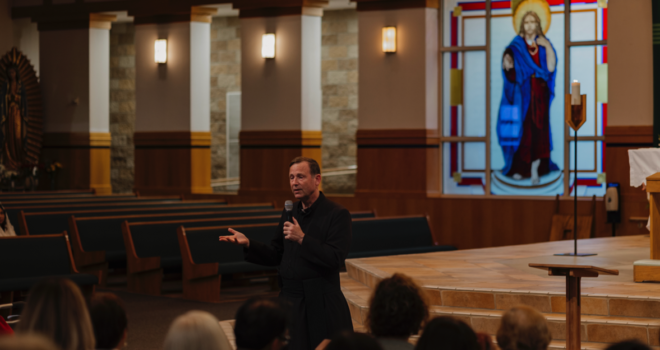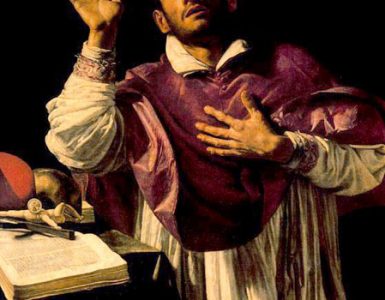Now more than ever we need good teachers—most especially, teachers of Catholic doctrine. Ironically, we’ve never lived in a society with so much access to information, thanks to the internet, but at the same time, never have we lived in a world with so much confusion.
In this brief essay we would like to point out specific ways that we can make a sincere but concerted effort to form solid, authentic teachers—teachers that convey the Truth of Jesus Christ, the Incarnate Word and Truth itself.
1. Truth
The last thing that the world needs are so-called teachers who preach their own opinions, ideas, and esoteric theories that lie far from the truth. Perhaps this is an obvious statement, but it must be expressed: a teacher must impart and teach the truth. If he or she cannot (or will not), then stay away from teaching. That being said, let us delve into some of the sources where we can find the truth.
2. The Word of God
The best source from which we can imbibe the clear waters of truth is the Bible, the inspired word of God, authored by God Himself. Each of us ought to own a good Catholic Bible. The New Jerusalem Bible would be among the best translations from its original languages. The Didache Bible offers not only the words of Scripture but also an excellent running commentary at the foot of each page, taken from the Catechism of the Catholic Church.
3. Vatican II Documents
The documents from the Second Vatican Council are of primary importance. There are 16 in total, but the four Dogmatic Constitutions are particularly essential: Dei Verbum—on the Bible and Divine Revelation; Sacrosanctum Concilium—on the Mass and Liturgy; Gaudium et Spes—on the problems the Church confronts in the modern world; and Lumen Gentium—on the hierarchical structure of the Church and the universal call to holiness.
4. The Catechism of the Catholic Church
The Catechism, published under the supervision and auspices of Pope Saint John Paul II in the early 90s, is a sure guide to learning the authentic teaching of Holy Mother Church.
The four pillars of the Catechism explain clearly the essence of Catholic doctrine:
1) Dogma-Creed—explaining the various parts of the Creed or Profession of faith said at every Sunday Mass;
2) The Seven Sacraments—channels of grace for our sanctification and salvation;
3) Morality—the explanation in detail of the ten Commandments; and
4) Prayer—communication and dialogue with God as the key to our salvation.
5. Love the Topic
Saint Augustine points out two other important factors to be accentuated in authentic teaching. The first of these is that the teacher should be totally immersed in the subject that he is teaching as well as have a true love for the material he is transmitting.
After Mass, a woman once commented to the celebrant priest, “I believe in what you said because you believe it!” A salesman will not sell his product if he is not convinced that the product is worth its price; the same goes with teaching. For Catholic teachers, catechists, priests, and missionaries, the topic is not a thing or a product or a commodity. Rather, our preaching is the Person of Jesus Christ, the Son of the living God!
6. Love the People
The second point of this equation, according to Augustine, is that the teacher should truly love his students. He should have a great desire that through his teaching the students will get to know, love, and serve Christ so that one day they may be with Him forever in heaven. This is true love, which, according to St. Thomas Aquinas, means “willing the good of the other.” The maximum good is to be united with Jesus forever in heaven, but it starts with getting to know and love Him first here on earth.
7. Pray Before and After Teaching
Our teaching should be immersed in an authentic spirit of prayer. As a teacher for many years, I always start by inviting the Blessed Virgin Mary to help us with her prayers and to be with us in ours. Also of paramount importance is inviting the Holy Spirit to be present in the transmission of the spiritual message. As the Holy Spirit inspired the Apostles 2000 years ago at Pentecost (Acts 2), so He can help us teachers be fully alive in and on fire with the Truth. When one’s teaching is made a prayer, by His grace, the Truth is transmitted, understood fully, and lived out.
8. Storytelling
Something about stories resonates with the human psyche. Perhaps the strongest proof of this is shown by the greatest Teacher of all. A brilliant, simple yet profound conveyer of Truth, this Teacher was the consummate storyteller: Jesus Christ. We can read His teachings in the four Gospels: Matthew, Mark, Luke, and John. What were these stories that the master-Teacher Jesus employed in His pedagogical method? The parables! To name a few, there’s the Good Samaritan (Lk. 10), the Prodigal Son (Lk. 15), the Sower (Mk. 4), Rich Fool (Lk. 12), and the Parable of the Talents (Mt. 25). Both in conversation and in teaching, we can easily observe the power and appeal of a good story! A good teacher should know when to tell a story, in what context, and how to convey its proper and intended meaning.
9. A Prayer-Full Spirit and Life
One of my favorite writers, also a preacher, teacher, and radio and TV evangelist, is Venerable Fulton J. Sheen. Millions of Americans were enthralled by his TV teaching. A truly brilliant bishop, writer, and missionary, Sheen did not attribute his success to himself. Quite the contrary, he attributed his oratorical success to God through a deep prayer life. He attributed it to his daily Holy Hour, which he called “the Hour of Power.” In more than 50 years as a priest, Sheen stated that he never missed praying his Holy Hour—the Hour of Power—even once. This was the ultimate source of his light, inspiration, and eloquence as a teacher. It was Jesus, the Supreme Master and Teacher, that enlightened his mind and ignited his heart as preacher.
So, let us beg the Lord to raise up more inspired teachers, who, by following in the footsteps of Jesus, the greatest of all Teachers, will uphold and transmit the fullness of the Truth in all times and places so as to reap an eternal harvest for the Kingdom of God.
Photo provided by the author












